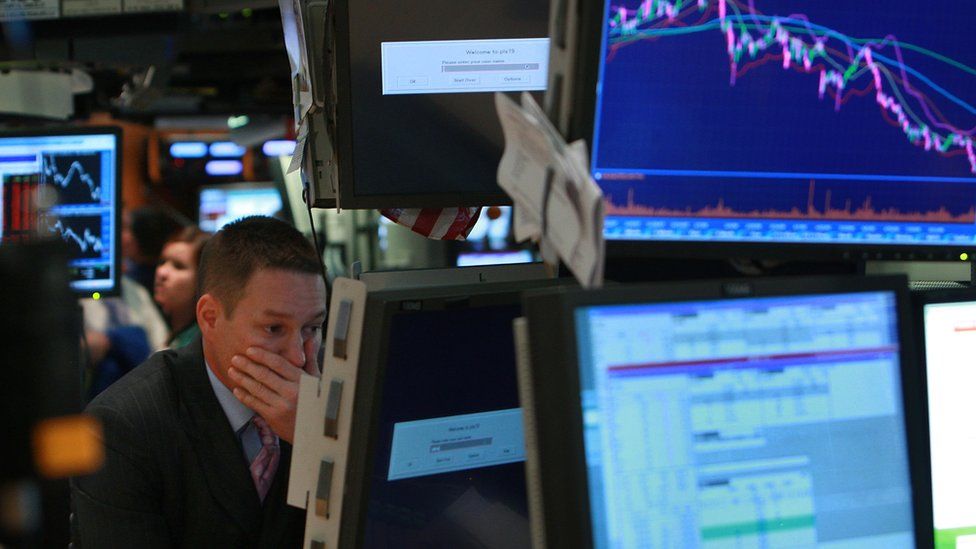The panics of the Fed
- Published

What do US central bankers do during a financial crisis?
On a typical day, central bankers in the US spend their time monitoring bank activity and trying to understand economic data, adjusting interest rates to assist price stability and employment.
But every so often, the economy faces a financial panic that forces the Federal Reserve to take additional action.
During the financial crisis of 2007-2009, that meant launching loan programs, brokering takeovers of faltering companies, and pumping trillions of dollars into the economy in a bid to stave off economic collapse.
The aggressive response marked a major shift. Remember - just a century earlier, the US didn't have a central bank at all.
Here is a look at how the Fed's approach to financial crises has evolved.
Panic of 1907
Panics flare when there is suddenly a rush of demand for cash - creating a credit crunch for banks and other financial institutions that have loaned out the money.
In the 1800s, without a central bank to monitor the money supply, such episodes were frequent. Even the regular harvest cycle could cause problems, since farmers needed cash all at once to pay their workers.
Until the panic of 1907, however, the US was politically resistant to the idea of a central bank.
That year - when cash was already tight - word spread about the failure of a financial gamble by prominent bankers.
Investors hurried to pull money from firms associated with the bankers, worried - not necessarily rationally - their own funds might be at risk.
Without a central bank, a group of businessmen led by JP Morgan coordinated the response to the run, which included shoring up firms with money from the Treasury Department.
The panic stopped, but the economy took a severe hit anyway.
In the aftermath, bankers and lawmakers concluded the US needed a federally-backed institution that would control the currency and serve as a lender of last resort to banks, forestalling future panics.
Congress created the Federal Reserve in 1913.
The Great Depression
The Fed soon faced an episode that tested its ability to ward off problems.
In the late 1920s, a credit-fuelled stock market rally collapsed, and the economy entered a global recession, triggered in part by a move back to the gold standard.
Thousands of banks collapsed, the unemployment rate topped 20%, and US GDP contracted by more than a third.
The Fed took some steps to try to address the crisis, but many economists say the institution should have gone further.
They argue that officials were too concerned that more aggressive action would fuel risky, speculative behaviour.
Some say not intervening to stop bank collapses was particularly harmful, since it led others to become cautious about lending and spending, further slowing economic activity.
Eventually Presidents Herbert Hoover and Franklin Delano Roosevelt entered the picture, creating new central banking powers, such as authority for broader lending programmes and a guarantee of most bank deposits.
In some ways, however, it took the industrial boom spurred by World War II to really get the economy going again.
A Meltdown Avoided
On occasion, however, a lighter touch has appeared to be enough.
In 1998, officials at Long Term Capital Management contacted the Federal Reserve.
The hedge fund, which counted Nobel laureates among its stars, had more than $100bn (£74.2bn) in assets, and enjoyed close ties with most major financial companies.
But losses in Asian markets had brought it to the brink of failure.
Worried about the consequences of a meltdown for other firms, the Fed convened a group of companies to arrange a bailout. Eventually 14 firms injected $3.6bn and took ownership stakes.
The episode was resolved without bigger market problems and without using Fed funds.
But a decade later - as the US faced another crisis - some would cite it as an example of a missed opportunity when regulators should have imposed stricter rules for risky financial instruments.
Financial crisis of 2007-2009
In 2007, US housing prices started to falter - a sign of cracks forming in the US economy, which would later be declared in recession.
The chair of the Fed was Ben Bernanke, a professor who had studied the Fed's response to the Great Depression and was determined to avoid its mistakes.
The Fed put its traditional tools to use, slashing interest rates and injecting money into the economy with bond purchases.
Then officials went further.
They convinced Congress to launch lending programmes, and engineered the takeover of failing firms, proving willing to take on bad assets to get deals done.
And for the first time in decades they used the Fed's lender-of-last-resort powers to provide loans to financial companies that were not banks, including insurer AIG.
The moves drew fierce backlash, and fuelled a political movement angry about a banker bailout. But supporters said it stopped financial problems from spurring a bigger recession.
These days, with strong economic growth and low unemployment, the Fed has stopped or is reversing those programmes.
Some analysts, however, joke that officials also want room to manoeuvre, as they are already anticipating the next panic.
- Published28 November 2017
- Published2 November 2017
- Published20 September 2017